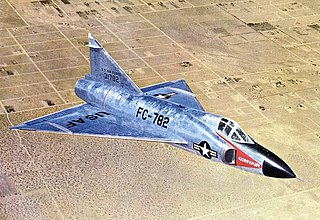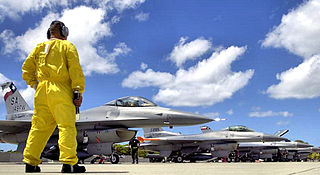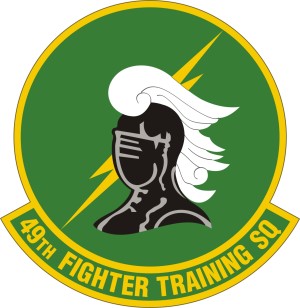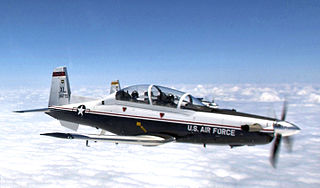
The Convair F-106 Delta Dart was an all-weather interceptor aircraft designed and produced by the American aircraft manufacturer Convair.

The Convair F-102 Delta Dagger was an interceptor aircraft designed and produced by the American aircraft manufacturer Convair. A member of the Century Series, the F-102 was the first operational supersonic interceptor and delta-wing fighter operated by the United States Air Force (USAF).

The Lockheed F-94 Starfire is a first-generation jet powered all-weather day/night interceptor aircraft designed and produced by Lockheed Corporation. It was the first operational United States Air Force (USAF) fighter equipped with an afterburner as well as being the first jet-powered all-weather fighter to enter combat during the Korean War.

The Century Series is a popular name for a group of US fighter aircraft representing models designated between F-100 and F-106 which went into full production. They included the first successful supersonic aircraft designs in the United States Air Force's service, which remained in active service well into the 1970s and 1980s with the Air Force Reserve and Air National Guard. Three later variants, the QF-100, QF-102, and QF-106, also continued in service, primarily as aerial target drones, until the late 1990s. The F-104G stayed in service with the Italian military until 2004. The NASA airborne science program maintains a group of F-104G in airworthy condition for use as test platforms and chase aircraft.

The Douglas AIR-2 Genie was an unguided air-to-air rocket with a 1.5 kt W25 nuclear warhead. It was deployed by the United States Air Force and Canada during the Cold War. Production ended in 1962 after over 3,000 were made, with some related training and test derivatives being produced later.

The 71st Fighter Squadron is an active squadron of the United States Air Force, part of the 1st Operations Group of the 1st Fighter Wing. Stationed at Joint Base Langley–Eustis, Virginia, the squadron serves as a training unit, flying the F-22 Raptor.

The 1st Operations Group is the flying component of the 1st Fighter Wing, assigned to the USAF Air Combat Command. The group is stationed at Langley Air Force Base, Virginia. The 1st Operations Group is the oldest major air combat unit in the United States Air Force, being the successor organization of the 1st Pursuit Group. The 1st Pursuit Group was the first air combat group formed by the Air Service, American Expeditionary Force, on 5 May 1918.

Dissimilar air combat training (DACT) was introduced as a formal part of US air combat training after disappointing aerial combat exchange rates in the Vietnam War.

The 319th Expeditionary Reconnaissance Squadron is a provisional United States Air Force unit stationed at Kadena Air Base, Japan, operating General Atomics MQ-9 Reaper unmanned reconnaissance vehicles.

The 149th Fighter Wing is a unit of the Texas Air National Guard, stationed at Kelly Field Annex, Joint Base San Antonio, Texas. If activated to federal service, the Wing is gained by the United States Air Force Air Education and Training Command.

The 62d Fighter Squadron is part of the United States Air Force 56th Operations Group at Luke Air Force Base, Arizona. It operates the Lockheed Martin F-35A Lightning II aircraft conducting advanced fighter training.

The 5th Flying Training Squadron is part of the United States Air Force's Air Force Reserve Command serving as a reserve associate squadron operating with the 71st Flying Training Wing at Vance Air Force Base, Oklahoma. It operates the Raytheon T-1 Jayhawk, Northrop T-38C Talon, and Beechcraft T-6A Texan II aircraft conducting flight training in support of the 71st Operations Group.

The 49th Fighter Training Squadron is part of the 14th Flying Training Wing based at Columbus Air Force Base, Mississippi. It operates T-38 Talon aircraft conducting flight training.

The 84th Flying Training Squadron was part of the United States Air Force 47th Flying Training Wing based at Laughlin Air Force Base, Texas. It operated Beechcraft T-6 Texan II aircraft conducting flight training.

The 87th Flying Training Squadron is part of the United States Air Force 47th Flying Training Wing based at Laughlin Air Force Base, Texas. It operates T-38 Talon aircraft conducting flight training.

The 456th Fighter-Interceptor Squadron is an inactive United States Air Force unit. Its last assignment was with the Air Defense Command San Francisco Air Defense Sector stationed at Oxnard Air Force Base, California. It was inactivated on 18 July 1968.

The 329th Fighter-Interceptor Squadron is an inactive United States Air Force unit. Its last assignment was with Los Angeles Air Defense Sector at George Air Force Base, California, where it was inactivated on 1 July 1967.

The 84th Combat Sustainment Group is an inactive United States Air Force (USAF) group last assigned to the 84th Combat Sustainment Wing at Hill Air Force Base, Utah, where it was inactivated in 2010. The group was formed in 1942 as the 84th Bombardment Group, one of the first dive bomber units in the United States Army Air Corps and tested the Vultee Vengeance, proving that aircraft unsuitable as a dive bomber. As an Operational Training Unit, it was the parent for several other bombardment groups, but from 1943 until it was disbanded in 1944, trained replacement aircrews as a Replacement Training Unit designated the 84th Fighter-Bomber Group.

The 186th Airlift Squadron is a unit of the Montana Air National Guard 120th Airlift Wing located at Great Falls International Airport, Montana. The 186th is equipped with the C-130H Hercules.






















